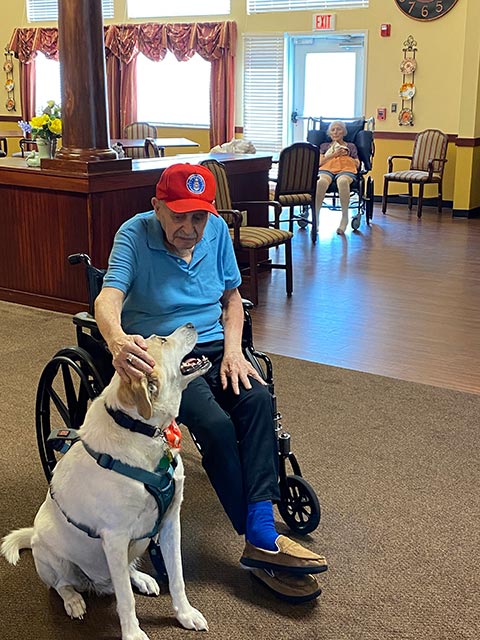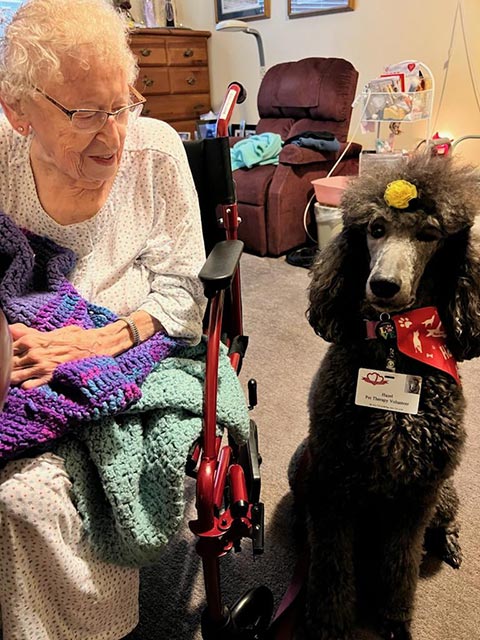Pet Therapy Provides Comfort and Delight for Hospice Patients
“Dogs do speak, but only to those who know how to listen.”
—Author Orhan Pamuk, My Name Is Red

There’s no denying the special bond between people and their pets, who provide happiness, comfort, and companionship. The same is true for pet therapy dogs and hospice patients.
The visits provide emotional, physical, and psychological benefits that are far-reaching for patients on end-of-life care, their families, as well as for the therapy dogs and their handlers. “It’s a win-win all the way around,” said Ellen Holland, Coordinator of the Pet Therapy Program with Heart to Heart Hospice in Southwest Indiana.
Ellen said their Heart to Heart Hospice Pet Therapy team currently has 14 dogs and 10 handlers. While they are typical dogs who love to play, their extensive training and certification process prepares them for hospice visits. “When they put on their Heart to Heart scarf and nametag, it’s like they know they’re going to work,” she said.
Benefits of Pet Therapy

Pet therapy, also called animal-assisted therapy, is proven to help patients physically, emotionally, mentally, spiritually, and relationally, including those on hospice and palliative care. One study concluded that pet therapy helps facilitate communication, results in positive emotional responses, enhances physical relaxation, and motivates physical activation.
The benefits of pet therapy for patients include:
- Reducing blood pressure and improving overall cardiovascular health
- Releasing “feel good” endorphins (serotonin, prolactin, and oxytocin) that produce a calming effect
- Stimulating memories and communication
- Decreasing pain and making pain medications more effective
- Providing companionship and judgment-free interactions
- Offering a fun distraction
- Providing tactile interaction through petting
Pet Therapy Visits

When a patient expresses a love for dogs or an interest in pet therapy to any hospice team member (nurse, social worker, chaplain, aide, etc.), the nurse then makes a referral for an assessment and evaluation. Once approved, the same dog and handler visit the assigned patient, whether it’s in the home or a residential facility, so they can build rapport. They typically visit twice a month and sometimes weekly for patients in residential facilities.
Sarah Boren has been a faithful pet therapy volunteer for 12 years. She shares what a typical visit looks like.
“When the handler and dog walk into the room, they usually put a smile on the patient’s face. This is the beginning of when troubles are forgotten,” she said. The handler asks, “Would you like to look at the dog? Would you like me to put the dog close to you?”
Most of the dogs with the Southwest Indiana pet therapy team are medium to large dogs. Their intense training helps them gently interact without pawing or jumping on the patients.
During the visit, the dog calmly interacts with the patient, who sometimes wants the dog in their bed and hugs, pets, and snuggles the canine. They share stories about their own dogs from years past. If desired by the patient, the dogs can play fetch, do simple tricks, and accept treats.
Many times, handlers and family members can visibly see the patient relax. Sarah remembers one patient with dementia who had difficulty remembering names, but she amazed nurses when she remembered her Goldendoodle Simon’s name. One family requested Simon come lay with their loved one at the end of life, and he provided comfort in those final days. Additionally, health care workers told Sarah they need Simon’s visits as much as the patients do, giving them a bright spot during an otherwise stressful day.
Noting the amazing intuition of dogs, Sarah and Ellen both have witnessed many things that can’t be explained, including a dog alerting them to a patient on the floor in a facility (in what appeared to be an empty room) or seeking out someone who really needed comfort.
Ellen said that handlers develop relationships with the patients and caregivers as well. They learn what the patient wants and follow their wishes for the level of interaction. Handlers help patients who are nonverbal or unresponsive touch the dog. When the patient or dog is tired, it’s important for handlers to understand when to end the visit.
Training and Certification

Pet therapy dogs with Heart to Heart Hospice are owned by their handlers, who are selfless volunteers with the Pet Therapy Program. Training takes a lot of time and personal resources, including the $1,000 cost of training and certification. Ellen said that the dogs and handlers go through four six-week classes (beginner, intermediate, advanced, and pet therapy), often through PetSmart or PAWSH in Indiana.
The handlers need an additional eight hours of training, interviews, references, background checks, and continued at-home training with the dog. Both the dog and owner are evaluated by Therapy Dog International (TDI). Amy Hofmann, the TDI evaluator in Southwest Indiana, is also a Pet Therapy Volunteer for Heart to Heart Hospice, so she knows the unique needs of hospice patients and helps educate owners who are interested in volunteering. A real asset to the program, she helps volunteers get comfortable on their first visit and leads group visits to residential facilities.
The dogs and owners are specifically trained for hospice visits. Though the dog is the main attraction, the handlers interact and bond with the patient and caregivers as well.
“Our volunteers are so dedicated to helping people, and they go above and beyond to be hospice volunteers,” praised Ellen. Many of the TDI-certified dogs and handlers also visit a residential facility each Sunday; anywhere from three to 10 dogs meet with residents in the common area for fun, comfort, and interaction.
It’s important to note that pet therapy dogs are different from service or emotional support animals. Pet therapy animals are trained to provide affection, comfort, and support to people in a variety of settings, including hospitals, nursing homes, hospices, schools, etc. They are trained to interact with all kinds of people.
Conversely, service animals are trained to provide specific services for people with disabilities, such as autism, blindness, epilepsy, or the hearing impaired. Finally, emotional support animals are pets that are not specially trained but provide emotional support to their owners.
Heart to Heart Hospice Pet Therapy
If you have a loved one on hospice, inquire if Heart to Heart Hospice in your area offers pet therapy visits. The benefits are immediate and long-lasting, and the comfort of a dog can be measured in smiles.

